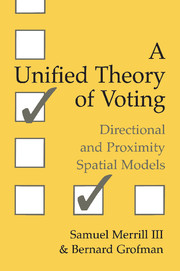Book contents
- Frontmatter
- Contents
- List of Tables and Figures
- Acknowledgments
- 1 Introduction
- Part I Models of Voter Behavior
- 2 Alternative Models of Issue Voting
- 3 A Unified Model of Issue Voting: Proximity, Direction, and Intensity
- 4 Comparing the Empirical Fit of the Directional and Proximity Models for Voter Utility Functions
- 5 Empirical Model Fitting Using the Unified Model: Voter Utility
- 6 Empirical Fitting of Probabilistic Models of Voter Choice in Two-Party Electorates
- 7 Empirical Fitting of Probabilistic Models of Voter Choice in Multiparty Electorates
- Part II Models of Party or Candidate Behavior and Strategy
- Postscript
- Appendices
- Glossary of Symbols
- References
- Index
3 - A Unified Model of Issue Voting: Proximity, Direction, and Intensity
Published online by Cambridge University Press: 04 December 2009
- Frontmatter
- Contents
- List of Tables and Figures
- Acknowledgments
- 1 Introduction
- Part I Models of Voter Behavior
- 2 Alternative Models of Issue Voting
- 3 A Unified Model of Issue Voting: Proximity, Direction, and Intensity
- 4 Comparing the Empirical Fit of the Directional and Proximity Models for Voter Utility Functions
- 5 Empirical Model Fitting Using the Unified Model: Voter Utility
- 6 Empirical Fitting of Probabilistic Models of Voter Choice in Two-Party Electorates
- 7 Empirical Fitting of Probabilistic Models of Voter Choice in Multiparty Electorates
- Part II Models of Party or Candidate Behavior and Strategy
- Postscript
- Appendices
- Glossary of Symbols
- References
- Index
Summary
… spatial [i.e., proximity] and directional theories may not be incompatible but instead may complement one another in explaining patterns of voting behavior.
Torben Iversen, “Political Leadership and Representation in West European Democracies” (1994: 49)Limitations of Pure Models
In Chapter 2, we introduced two pure models of voting behavior: the Downsian proximity model and the Matthews directional model. We saw that the former could be modified by discounting (Grofman), the latter by taking overall voter or candidate intensity into account (Rabinowitz and Macdonald). Even with these emendations, each of these models singles out one (or in some cases two) aspects of voter decision making. We expect each to be of limited usefulness by itself in explaining voter behavior, and empirical studies bear out this expectation (see Chapters 4–7). In this chapter, we specify a unified model intended to incorporate the features of all the various pure models.
In order that utility not increase without bound as candidates recede from the neutral point, Rabinowitz and Macdonald (1989) incorporate into their model a penalty for extremism, on the grounds that voters will tend to find unacceptable a candidate or party whose stands are too “far-out.” To this end, they define a circle or region of acceptability, centered at the neutral point, beyond which a candidate suffers a loss of utility for all voters. Although Rabinowitz and Macdonald consider the “region of acceptability” to be part of the definition of their directional model, they provide no decision rule for specifying which parties fall into the region.
- Type
- Chapter
- Information
- A Unified Theory of VotingDirectional and Proximity Spatial Models, pp. 38 - 51Publisher: Cambridge University PressPrint publication year: 1999



